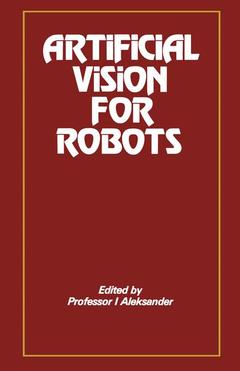Artificial Vision for Robots, 1982
Langue : Anglais
Auteur : Aleksander I.

I. ALEKSANDER Department of Electrical Engineering and Electronics BruneI University, England The three key words that appear in the title of this book need some clarification. First, how far does the word robot reach in the context of indus trial automation? There is an argument maintaining that this range is not fixed, but increases with advancing technology. The most limited definition of the robot is also the earliest. The history is worth following because it provides a convincing backdrop to the central point of this book: vision is likely to epitomize the technolo gical advance, having the greatest effect in enlarging the definition and range of activity of robots. In the mid 1950s it was foreseen that a purely mechanical arm-like device could be used to move objects between two fixed locations. This was seen to be cost-effective only if the task was to remain fixed for some time. The need to change tasks and therefore the level of programmability of the robot was a key issue in the broadening of robot activities. Robots installed in industry in the early 1960s derived their programmability from a device called apinboard. Ver tical wires were energized sequentially in time, while horizontal wires, when energized, would trigger off elementary actions in the manipulator arm. The task of reprogramming was a huge one, as pins had to be reinserted in the board, connecting steps in time with robot actions.
1 Introduction.- The Front End 12; Image Processing 13; Pattern Recognition 13; Applications 14; Structure of the Book 16; Future Directions for Robot Vision 21.- I: Techniques.- 2 Software or Hardware for Robot Vision?.- 25; Direct versus Iterative Implementation 26; Sequential versus Parallel Algorithms 28; Computation versus Use of Look-up Tables 31; Computer Addressing versus Raster Scanning 34; Structural versus Correlative Comparisons 36; Conclusion 38.- 3 Comparison of Five Methods for the Recognition of Industrial Parts.- 43; Discussion of This Method 49; Conclusion 55.- 4 Syntactic Techniques in Scene Analysis.- 58; Acquisition of Images and Extraction of Features 60; Edges 61; Lines 62; Formal Description of a Scene 66; Figures 68; A Computational Model: The Pandemonium 71.- II: Applications.- 5 Recognition of Overlapping Workpieces by Model-Directed Construction of Object Contours.- 77; The Scene 78; The Model 78; The Scene Representation 80; Production Rules for Reference Objects 81; The Recognition Procedure 86; Results 90.- 6 Simple Assembly Under Visual Control.- The Experimental System 93; Picture Processing 99; The Parallel Projection Optical System 105; Object Location Using Parallel Optics 107; Calibration 109; Distributed Processing 111; Conclusion 112.- 7 Visually Interactive Gripping of Engineering Parts from Random Orientation.- 114; Problem Definition 115; Manipulative Techniques 118; The Integrated System 136; Concluding Remarks 143.- 8 An Interface Circuit for a Linear Photodiode Array Camera.- Circuit Operation 148; Programming 152; Components Used 152.- III: Adaptive Processing for Vision.- 9 Networks of Memory Elements: A Processor for Industrial Automation.- 155; Character Recognition — A Deterministic Problem to a Greater or Lesser Extent 156; Some Aspects of Industrial Pattern Recognition 159; Networks of Memory Elements for Pattern Recognition 161; Applications 168; Recognition of Piece-parts 170; Unconstrained Piece-parts 171; Identification of Highly Constrained Piece-parts 172; Pattern Detection in Unspecifiable Data 175; Summary 177.- 10 Computer Vision Systems for Industry: Comparisons.- Is it Difficult for Computers to Recognize Patterns? 179; Who Needs Pattern Recognition? 180; What the Automatic Eye Needs to See 182; What the Automatic Brain Needs to Compute and How 183; Special Architectures 191; Fixed Implementations 192; Conclusion: Pattern Recognition Comes of Age 192; Appendix 1 194.- 11 Memory Networks for Practical Vision Systems: Design Calculations.- 197; The RAM/Neuron Analogy 198; Single Layer, Randomly Connected Nets: Parameters and Definitions 200; Analysis of System Training and Responses 202; Analysis of Responses to Shapes 207; Alternative Structures for Future Development 212.- 12 Emergent Intelligence from Adaptive Processing Systems.- 215; Emergent Intelligent Properties 216; Level 0 Structures: Image Classifiers 218; Level 1 Structures: Decision Feedback 221; Level 2 Structures: a Preamble 223; Level 2 Structures: Emergent Properties 227; Level 3 Structures: the Attention Mechanism 230; Conclusion 231.
Date de parution : 03-2012
Ouvrage de 233 p.
14x21.6 cm
Disponible chez l'éditeur (délai d'approvisionnement : 15 jours).
Prix indicatif 52,74 €
Ajouter au panierMots-clés :
algorithms; automation; brain; cognition; computer vision; electrical engineering; electronics; image processing; programming; robot; robot vision
© 2024 LAVOISIER S.A.S.



